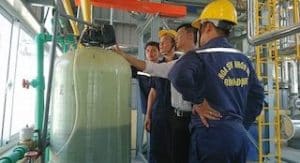Hard water softening systems, also known as Softeners, treat hardness in water using the ion exchange method, which is the most effective method, and is easy to operate compared to methods such as using lime, chemistry, boil…
Uses of Hard Water Softening System
– Limit scaling of water pipes and boilers.
– Reduce fuel consumption due to deposits
– Reduce consumption of washing powder and detergent
Advantages of Nam Viet hard water softening system
– Support for customers when warranty expires.
– The technical team will resolve the problem within 24 hours
– Provide technical guidance to the factory before handover
– Provide chemicals to quickly test hardness

Nam Viet Engineering provides guidance to Hoa Sen Binh Dinh Steel Sheet Factory Engineering
Principle of hard water softening system
The softening system operates on the principle of ion exchange. The filter material is ion exchange resin that will retain the ions that cause hardness and when enough hardness has been absorbed, it will be discharged through the regeneration process. Water passing through the Na-cationite resin layer will cause the following reactions:
2R-Na + Ca(HCO3)2↔ R2-Ca + 2 NaHCO3
2R-Na + Mg(HCO3)2↔ R2-Mg + 2 NaHCO3
2R-Na + CaCl2↔ R2-Ca + 2 NaCl
2R-Na + CaSO4↔ R2-Ca + Na2SO4
2R-Na + MgSO4↔ R2-Mg + Na2SO4
- According to the level of water filtration through the Na-cationite particle layer, more and more of its active Na groups are replaced by Ca2+ and Mg2+ ions of water.
- Finally, the exchange capacity of Na-catonite is completely exhausted.
- To restore the exchange capacity of Na-cationite, the filter material layer is washed with a solution with a high concentration of Na+ ions, for example table salt solution.
- This process is called reconstitution
2R-Ca + NaCl ↔ 2R-Na + CaCl2
- The process of softening water with Na-cationite can reduce the Ca2+ and Mg2+ content in water to very small values, leaving the pH and total alkalinity of the water unchanged.
- Choosing a water softening method must be based on the required water quality after treatment and the dissolved salt content in the source water.
- In all cases where the only need is to reduce hardness, the Na-cationite softening method is the most effective and economical.
Main components of an Industrial water softener system

Water softening system installed by Nam Viet ETC at Heineken Vung Tau factory
- Composite FRP filter tanks can withstand high pressure, are compact, and resist chemical corrosion. The filter tank contains filter material inside including sand and plastic granules.
- Autovalve Clack: Controls operating modes and regeneration completely automatically according to the pre-installed program.
- Electrical cabinets are used for control.
- Turbochargers
- Connecting pipe systems, valves, pressure gauges…
- The salt tank contains a salt solution that regenerates plastic beads.
- System support frame.
Nam Viet ETC is a unit specializing in providing and installing hard water softening systems using the ion exchange method. The system we install can handle water hardness <1mg/l, is easy to operate, easy to control and ensures no salt water leaks into the system, causing corrosion.
Please contact us for a free consultation. Hotline 0932 562 177


Bài viết liên quan
Drinking water treatment for pigs and issues to note
Drinking water for pigs in particular and water treatment in livestock farming in general is...
Pure RO bottled water filtration system
What is a bottled water filtration system? The bottled water filtration system is essentially an...
Commonly applied water disinfection methods
Water disinfection is a mandatory step in the drinking and drinking process. Natural water contains...